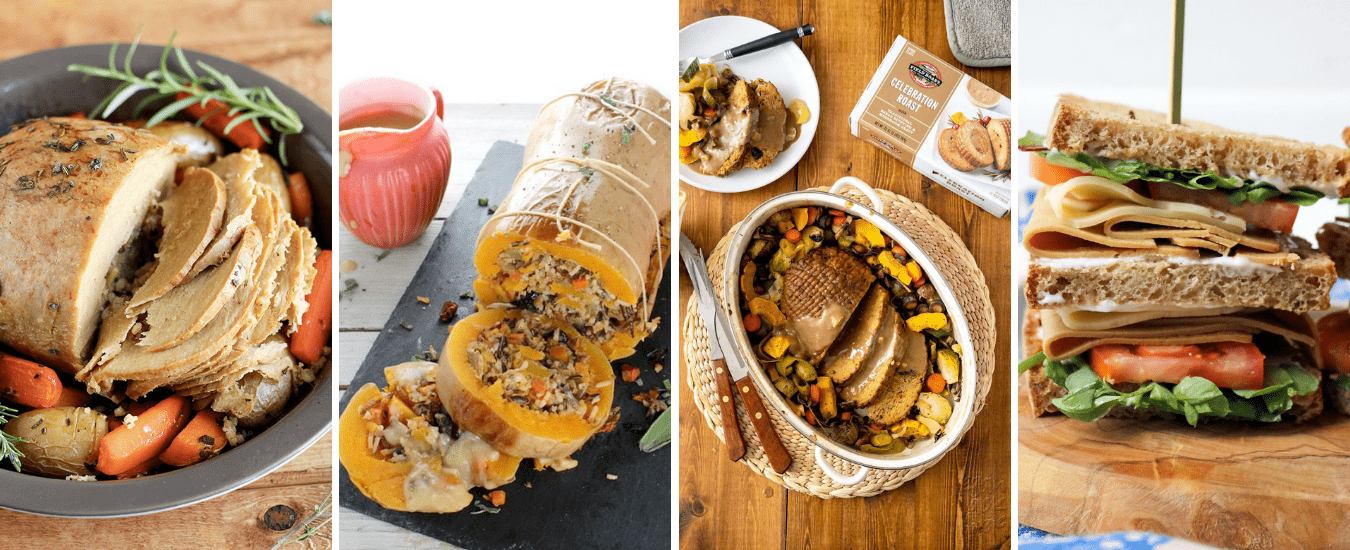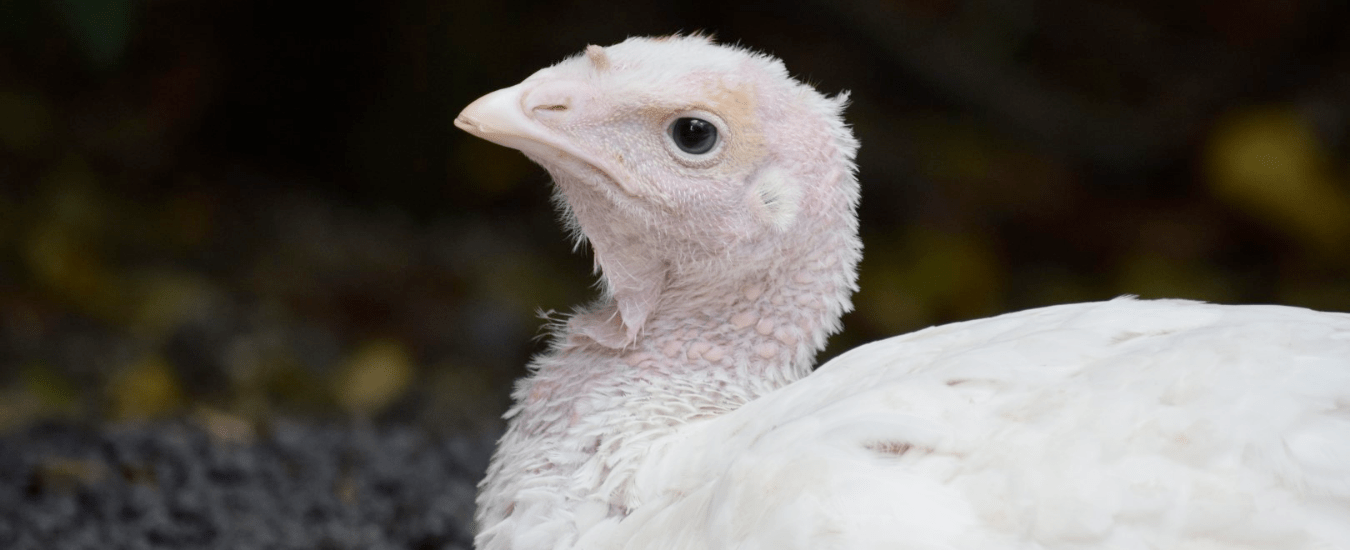
All About Turkey
About turkeys
Descendants from the native wild turkey of the United States, the domesticated turkey is the result of genetic alterations after years of selective breeding. Wild turkeys can fly up to 85km an hour, although average around 40km an hour. The turkeys who are farmed for their flesh, however, have been selectively bred to an abnormally large size, and their wings cannot support their body weight, making them unable to fly [1].
Not only are they smart birds, but they are also sentient, meaning they can perceive, feel, and experience things. All poultry species are sentient and are capable of feeling emotions, like joy, pain, fear, and stress [2]. Turkeys can display how they are feeling by changing the colour of their wattle! This is more prominent on the males than the females. Normally the wattle is red, which is a sign of health, and in males can also signify wooing. It turns blood red when they feel enlivened, frightened, or overwhelmed. When they are scared or anxious, the blood leaves the snood resulting in a blue colour, while a white or a pale colour means they are feeling unwell [3, 4].
Turkeys form strong social bonds with family and flockmates. They are loyal and protective of their friends and also love to play [5]. Their natural flocks have up to 50 individuals and there is a distinct hierarchy. They can easily distinguish a new individual [6]. They also mourn the death of their flock members, and anticipate pain, to the point of having heart attacks after watching their friends die [7].
The industry
The turkey meat industry kills approximately 650 million turkeys globally every year, equating to roughly 5.7 million tonnes of turkey meat [8]. The United States is the biggest consumer, creating over half of the demand [9]. While Australia’s demand is much lower, we still kill roughly 5 million individuals a year, with most turkeys being eaten during the Christmas period.
Selective breeding has resulted in the development of abnormally large and heavy breasts (for meat), which has made it impossible for turkeys to mate naturally. As a result, females are artificially inseminated. For this to happen, males must be ‘milked’. ‘Milking’ originally involved three workers, one to hold the male in a bent-over position, the second to stimulate him to ejaculate, and the third to collect the semen [10, 11].
Approximately 90% of them are farmed in intensive factory farms. The average shed holds up to 14,000 individuals, giving each bird the space of approximately an A3 sheet of paper. As the birds grow, the space in the sheds becomes more cramped. This makes it harder for them to exhibit natural behaviours, like spreading their wings, flying, perching, foraging, running, dust bathing.
The term “free-range” does not mean much for the turkeys. The Australian standards are full of “shoulds”, rather than ‘musts’. Turkeys on free-range farms have slightly lower stocking densities and have access to the outdoors. In saying this, “openings should be at least 35cm high and 40cm wide and provide an aggregate width of at least 2m per 1000 birds.” – meaning they could be smaller [12]. Keep in mind, a turkey will grow to be approximately 122cm tall, much taller than the recommended 35cm high openings [13]. Sick or injured turkeys can also be culled with cervical dislocation (up to 8kg), with CO2, or a captive bolt (over 8kg) [14].
The stress of confinement and an inability to exhibit natural behaviours results in neurotic behaviours, like feather plucking or cannibalism. To prevent this, the tip of their beaks and toes may be cut off. At just one day old, using an infra-red laser, the tip of the beaks are lasered off [15, 16]. Additionally, some turkeys have their toes trimmed using an infra-red laser to remove the toenail and nail bed to prevent the regrowth of the nail [17, 18].These individuals are not given any anaesthetic or post-treatment pain relief.
When they’ve reached their slaughter weight at 10-18 weeks old, they are transported to a slaughterhouse and hung upside down by their fragile legs. During an investigation, workers claimed that some of their legs rip off from their bodies due to their weight. They are dragged through an electrified water-bath for stunning, and then have their throats slit and are left to bleed out [19]. Some birds fight and lift their heads over the bath, leaving them to have their throats slit while they are conscious.
The environment
Our health
Eating processed meat, like turkey slices, increases the chance of developing stomach and colorectal cancer [22]. Scientists estimate that decreasing the amount of processed meat we eat by even just “half of a turkey sandwich” can lower the total number of colorectal cancers by about 20% [23]! Eating processed turkey products also increases the risk of heart disease, diabetes, and has been associated with an increased risk of death [24].
Confining 18,000 birds into a single shed creates a breeding ground for diseases. The birds are living in their own waste, are fed rendered animals (hooves, heads, bones, blood, feathers, and the bodies of those who died before slaughter) [25], making it possible for a virus to mutate and spread. In August, several thousand turkeys were destroyed after a new strain of the avian flu (bird flu) was found at two Victorian farms [26]. Currently, only workers or those in close proximity to the birds are at risk of catching the virus from the birds, as it is unlikely to spread from person to person. While the Government claims that this is not a risk for consumers, it is very possible that a virus such as this could continue to mutate and eventually be able to spread from human to human.
Workers on the farms are exposed to high levels of toxins in the air and suffer from respiratory issues, itchy and watery eyes, coughing, shortness of breath, wheezing, throat discomfort, and sneezing [27]. In addition, workers are expected to kill thousands per shift [28]. Australian research found that the repeated exposure to violence in a slaughterhouse causes psychological damage, with meatworkers having aggression levels that are similar to those of incarcerated populations [29]. Others experience violent dreams, PTSD, depression, paranoia, panic, and dissociation [30].

Vegan “Turkey” Recipes
Every year, around 650 million turkeys are killed for human consumption. These curious creatures deserve so much more than to become a meal. While you may think these substitutes taste slightly different, have a slightly different texture, or smell slightly different, these are small sacrifices to save the life of sentient beings.
Pre-Made Mock Turkey
Tofurky – Oven Roasted Deli Slices (Woolworths, Vegan Grocery Store, All About Empathy, Online)

Meet Banjo
Written by Bede, A Poultry Place
Banjo is one turkey who never turned up on a table at Christmas.
Banjo’s new life of waking up on a bed of straw and spending the morning on a grassy field before retreating to the shade of fruit trees to nap as the day warmed up was a far cry from the windowless shed he came from. That shed denied him the ability to do any of the things that come naturally to him and his mates, like dustbathing, flapping his wings, dancing, and running.
Despite his luck, Banjo carried the scars of having been a factory-farmed turkey. Part of his beak was cut off and never grew back; he had a slow-healing wound on his right shoulder where his brothers walked over him in the crowded shed to get food; and, his infant skeleton struggled to support his 15kg bodyweight.
He found his ‘15 minutes of fame’ by being selected to be the original poster boy for the factory-farmed turkeys in Australia: Big Birds, Big Cruelty campaign.
Banjo enjoyed a number of years of carefree life at A Poultry Place before he passed – much longer than his siblings who were slaughtered when they were just months old.





